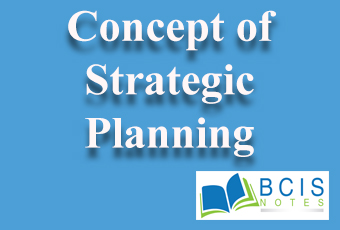
Concept of Strategic Planning
The concept of Strategic planning is one specific type of planning. Strategic Planning is a tool for organizing the present on the basis of the projections of the desired future. A strategic plan is a document used to communicate with the organization the organization’s goals, the actions needed to achieve those goals and all of the other critical elements developed during the planning exercise. In other words, a strategic plan is a road map to lead an organization from where it is now to where it would like to be in five or ten years. Strategic planning is an organization’s process of defining its strategy, or direction, and making decisions on allocating its resources to pursue this strategy. Strategy can be planned (intended) or can be observed as a pattern of activity (emergent) as the organization adapts to its environment or competes.
The strategy has many definitions but generally involves setting strategic goals, determining actions to achieve the goals, and mobilizing resources to execute the actions. A strategy describes how the ends (goals) will be achieved by the means (resources). The senior leadership of an organization is generally tasked with determining strategy. Strategy can be planned (intended) or can be observed as a pattern of activity (emergent) as the organization adapts to its environment or competes. Strategic planning is a process and thus has inputs, activities, outputs, and outcomes. This process, like all processes, has constraints. It may be formal or informal and is typically iterative, with feedback loops throughout the process. Some elements of the process may be continuous and others may be executed as discrete projects with a definitive start and end during a period. Strategic planning provides inputs for strategic thinking, which guides the actual strategy formation. Typical strategic planning efforts include the evaluation of the organization’s mission and strategic issues to strengthen current practices and determine the need for new programming. The end result is the organization’s strategy, including a diagnosis of the environment and competitive situation, a guiding policy on what the organization intends to accomplish, and key initiatives or action plans for achieving the guiding policy.
The organization’s leaders may have a series of questions they want to be answered in formulating the strategy and gathering inputs, such as:
- What is the organization’s business or interest?
- What is considered “value” to the customer or constituency?
- Which products and services should be included or excluded from the portfolio of offerings?
- What is the geographic scope of the organization?
- What differentiates the organization from its competitors in the eyes of customers and other stakeholders?
- Which skills and resources should be developed within the organization?
Situational Analysis
Situation analysis refers to a collection of methods that managers use to analyze an organization’s internal and external environment to understand the organization’s capabilities, customers, and business environment. Situation analysis helps you define where you are standing currently, and what should be your actions to progress further. Situation analysis also means forecasting the results if a decision is taken in any direction. The fast-changing environment and people’s lifestyles are demanding regular analysis to provide you with a snapshot of where your company is placed in the business environment, and to present you with the opportunities to develop and enhance growth. The situation analysis tells you what is your organization’s and product’s position and the options that you have to develop it further. It can be said to be a very complex type of analysis and generally speaking, every business plan, depending on its purpose, is going to include the situational analysis concept. In this respect, you need to take a look at your current product, target market, distributor network, competitors, financial analysis and external forces. As you have probably guessed, the way to look into and evaluate those factors can be through different models. These models will offer you a structural way of thinking, in order to avoid confusion.
The situation analysis, similar to the market analysis is a concept, comprising different theories such as the 5C’s, SWOT analysis, Porter’s Five Forces and PEST Analysis. Some marketers affirm that general situation analysis can be summarized in a SWOT format. However, from other experts’ point of view, it will be incorrect to look at the SWOT as a result of the situation analysis instead of as a component of it.
You may also like: The Planning Function

Leave a Reply